
Content marketing done with purpose can help your company stand out for the right reasons, regardless of your size or budget.
To succeed with content you’ve got to continue to grow as a marketer and adapt your skillset to stay ahead of the curve.
However, staying up to date in this ever-evolving field can be a pain as every variable is in a constant state of change.
To counter this, review these important statistics and facts to learn what is working and what is not with content marketing for both marketers and business owners alike.
Content Marketing Strategy Statistics
1. 74% of surveyed B2B executives created content with original data and research as they found it to be the most effective marketing tactic. (Source)
The godfather of marketing Seth Godin once said, “Content marketing is the only marketing left.” He said this because most other forms of marketing don’t provide enough value and relevance to consumers anymore, since they are too focused on promotion. Instead, create content with original and useful information that your audience can’t find elsewhere.
2. 42% of B2C marketers plan to increase their content marketing spending over the next 12 months. (Source)
As other marketing mediums become less effective, it seems content marketing is where many marketers turn to reach their customer base in a non-disruptive way.
3. 82% of consumers feel more positive about a company after reading their custom content. (Source)
Content marketing is all about building trust with your customers. If a person gets value from consuming your content, than that’s a step in the right direction towards building trust.
4. The output of content per brand increased 35% per channel in 2015, but content engagement decreased by 17% in the same timeframe. (Source)
All marketers realize that content works to reach people over other marketing strategies, which has lead to more companies investing in content. With more content published every day, the more difficult it is for content in any form to stand out and drive results as consumers are inundated with options.
5. 60% of B2C marketers and 63% of B2B marketers don’t have a documented content marketing strategy in 2017. (Source)
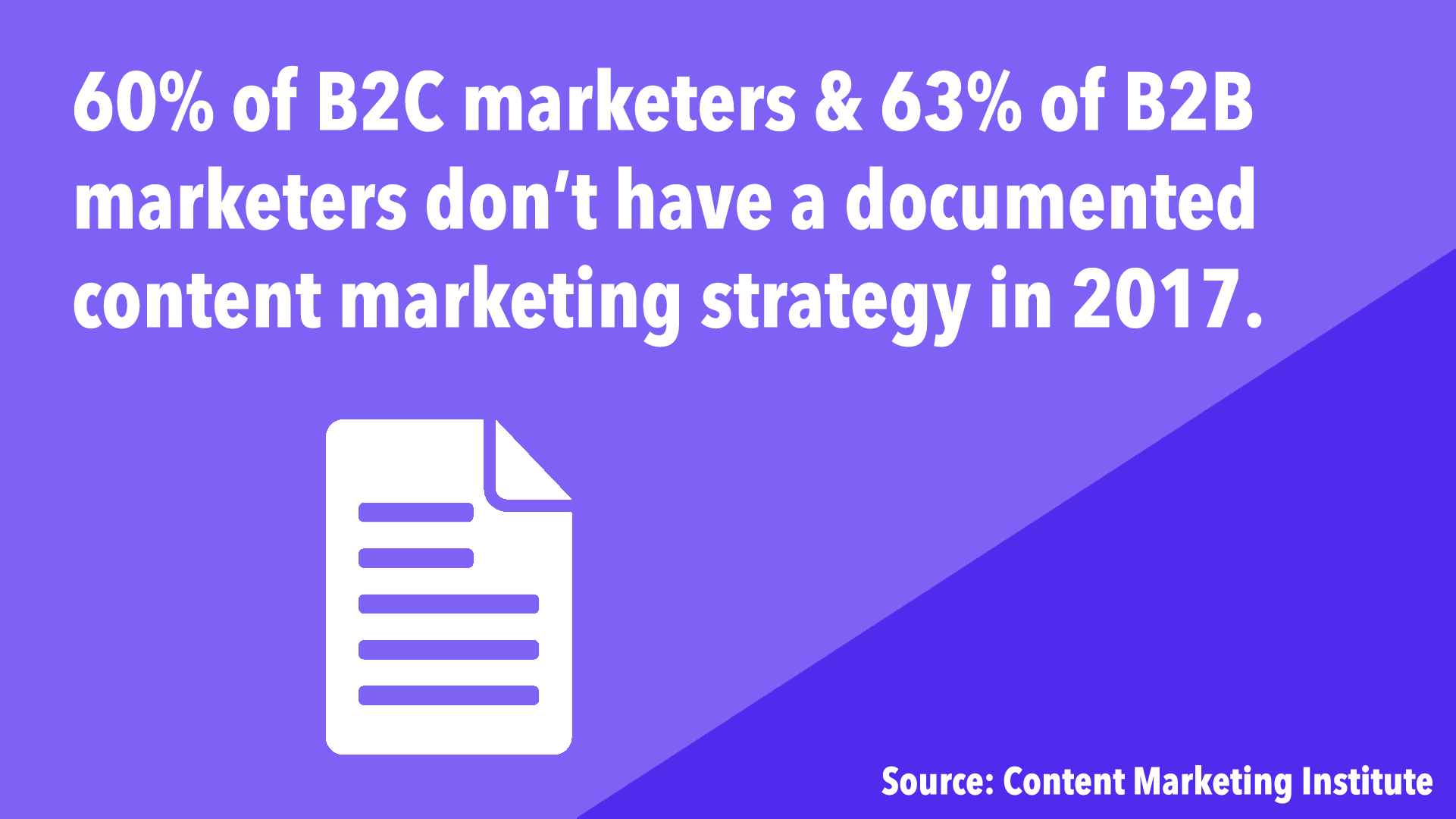
Surprisingly, being organized and systematic with your approach to content marketing will still give you a strategic advantage over a majority of competitors.
6. 21% of U.S. marketers planned to buy content marketing technology in 2017, as compared to 29% in the previous year. (Source)
Although many marketers are still slow to document their content strategy, many realize that the right toolkit is important to help automate parts of the process. This is why many are still investing in the right software to manage how their content is created, optimized, promoted and measured. Fewer marketers are investing in technology for content marketing this year as compared to 2016, since many already have the essential content tools.
7. 37% of content marketers never complete a content audit. (Source)
Similarly to the stark reality that most content marketers haven’t invested in a documented strategy, many haven’t taken the time to audit their progress with content. This is a big mistake as they are neglecting to pause their efforts, review the bigger picture with content and identify existing gaps in their overall approach.
For example, after conducting a content audit, Microsoft discovered that 30% of their content had never been visited. They removed the unwanted content on their website as it was diluting the effectiveness of their most useful information, something they’d never know about unless they did an audit.
8. Companies with ten employees or less use an average of six different content marketing tactics. (Source)
The more staff dedicated to content marketing the easier it is to experiment and invest in a few different channels and tactics to see what resonates with your audience. This is a good reference point, but don’t think using six different content tactics is the key to success. The best tactics are the one’s that drive results for your company, no matter the number.
9. According to survey respondents, the three most effective types of content in order of effectiveness are research reports, blog posts and podcasts/videos. (Source)
The same survey found that research reports and podcasts/video are the most difficult types of content to create, while blog posts were the least difficult compared to other content types.
Consistently reviewing what types of content work best for your industry, customer base and goals will help give your content strategy a stronger focus. Determining what format will be able to drive the biggest impact can help your organization use your budget and resources on content effectively.
10. 87% of B2B marketers predict that at least 10% of their content will be interactive in 12 to 24 months. (Source)
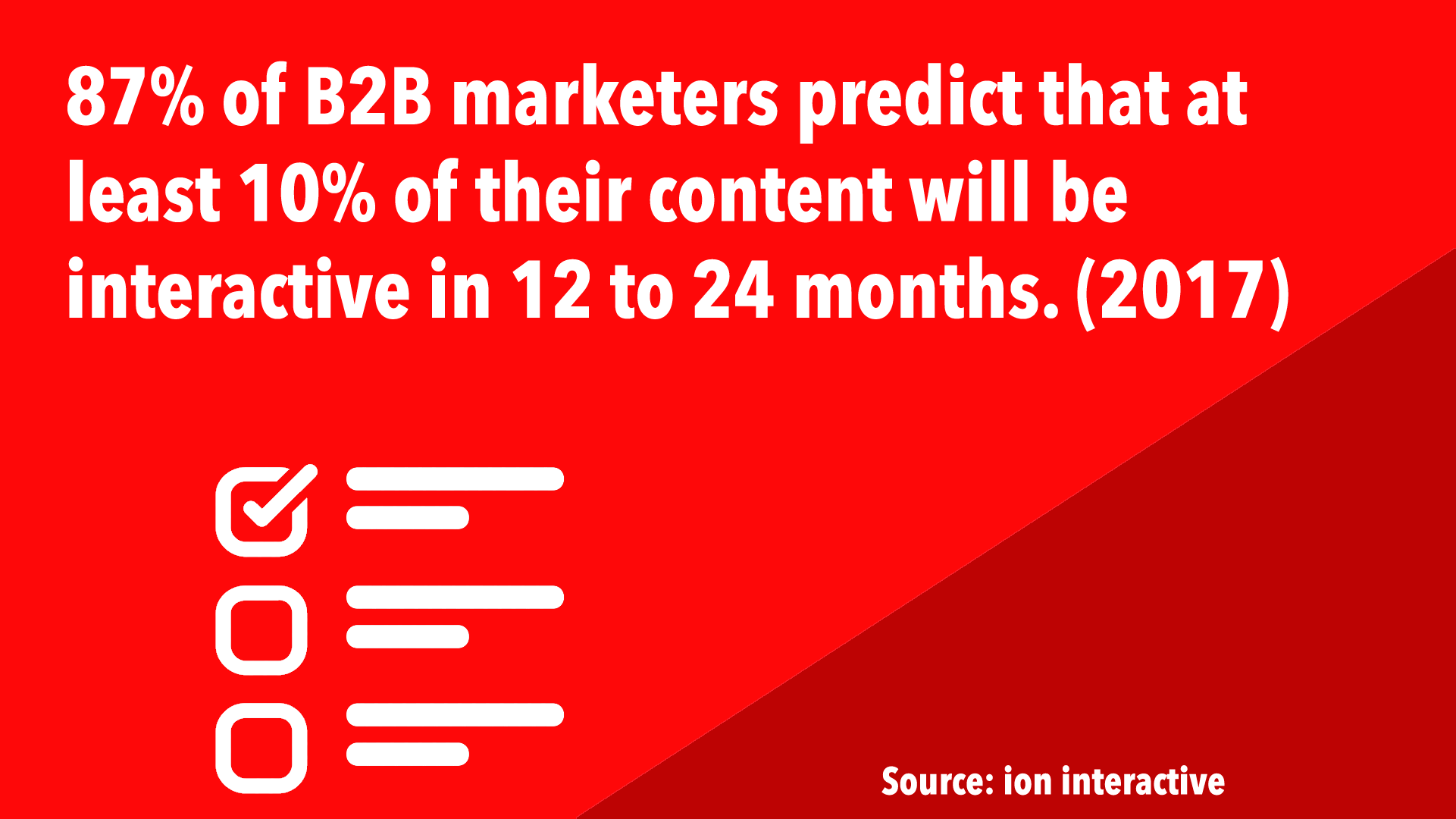
Standing out with your content marketing strategy today is difficult. Consider adding assessments, calculators, contests, quizzes, interactive infographics, games, responsive lookbooks or another format of interactive content to your approach to marketing to reach your audience and engage them in a way that differentiates your brand from competitors.
Content Marketing Creation Statistics
11. 65% of senior marketing and IT executives believe that visual content is essential to communicating a brand’s story, but only 27% have systems in place to aggregate, organize and manage their assets across departments. (Source)
The benefits of content marketing are well-established, but still many marketers are creating content in an informal way to reach their audience, an approach that isn’t sustainable. This is a missed opportunity as marketers that have a system and strategy in place are more successful than those who don’t.
12. Short form content (less than 1,000 words) dominates the most shared B2B content, although long form content on average gets more shares. (Source)
When creating content think about where and when different formats of content work for your audience. Refer to my previous piece to learn how to decide whether long or short form content is appropriate at a given moment.
13. 48% of respondents say a lack of content creation resources is their most significant barrier to achieving their goals. (Source)
When you’ve got limited access to what you need, repurposing your existing content into other formats is a useful way of generating more visibility for your efforts without reinventing the wheel.
14. 70% of marketers expect their organization to make more content in 2017. (Source)
This is a tough pill to swallow. More isn’t always better, but is often necessary to compete across channels. There isn’t a magic number of blog posts or podcast episodes to create each week, but it’s clear that the volume of content you’re creating needs to increase overtime in order to compete.
15. 57% of marketers surveyed said relevant content creation was the most effective SEO tactic. (Source)
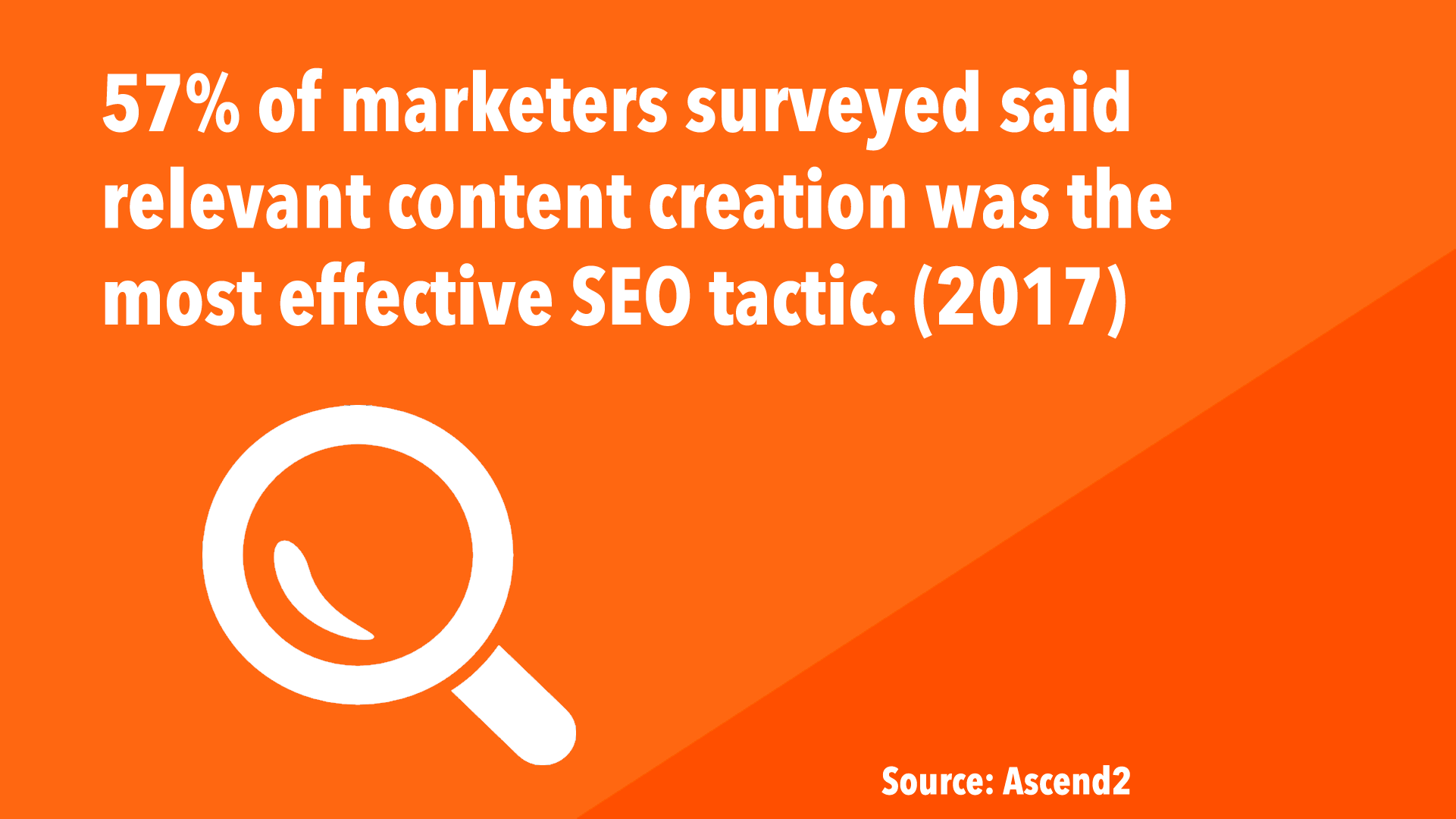
There are many SEO factors to optimize for, but it’s clear that creating original, useful and entertaining content on relevant subjects is the foundation for a strong SEO strategy.
16. 60-70% of content produced by B2B companies goes unused and 87% of B2B marketers say they struggle to create content that truly engages their buyers. (Source)
This issue comes down to two problems, one is not understanding who your audience is and what motivates them. The second issue is not knowing what topics to focus on when creating content for your customers. Address this dilemma by doing research to develop customer personas, as well as analyzing the content created by competitors in your industry.
17. Marketers who use video grow revenue 49% faster than non-video users. Video also drives a 157% increase in organic traffic. (Source)
Video is clearly one of the most engaging forms of content to invest in, as it is easy to consume and helps to humanize your brand, which helps build trust overtime.
18. Top-performing content was three times more likely to be emotionally focused. (Source)
Triggering an emotion with content is what drives us to share it, comment on it and take action. Think about the topics your content should focus on and explore the emotional angles of each subject.
19. On average, 75% of ideas are turned into a content asset, published once, and never reused or repurposed again. (Source)
Again, repurposing your content into different formats is one of the most underutilized ways of driving more visibility to your content without spending significant amounts of time and money. Perform a content audit to understand your existing inventory of content and what can be repurposed into a new, useful format like changing a series of blog posts into an infographic.
20. 59% of consumers globally would rather engage with content that’s beautifully designed than simple, even when short on time. (Source)

When developing content, it is important not to neglect the design of it as it heavily impacts a consumer’s interest in continuing to engage with it. Matching the expectation of consumers, wherever they are viewing content, is essential to ensure you’re serving engaging experiences that drives action.
Content Marketing Promotion Statistics
21. Globally, “making people laugh” was identified as the top personal motivator for sharing content. (Source)
To encourage the sharing of your content across social media and amongst publishers, humor is still a major driving force in gaining attention and triggering a response from consumers.
22. More than half of publishers’ 300 most-shared Page posts were Facebook videos. (Source)
Converting your existing videos and other formats of content into Facebook videos is a powerful way to drive more visibility. Whether they are just trailers to your other content, making use of Facebook video is essential today as the social network gives them higher priority in the news feed.
23. 55% of users on Pinterest use the platform to specifically find and shop for products. (Source)
When promoting content, understand how to position your products on Pinterest with content to make the most of this behavior and drive people to shop your product and service offerings.
24. For every 100,000 followers on Facebook, only 130 people will click on an organic post. (Source)
Paid advertising on Facebook and social media is an important consideration within your content strategy as organic reach continues to fall and it becomes necessary to promote content to ensure it’s seen and engaged with.
25. Fewer than 30% of B2C marketers said they use the following social media platforms: Vimeo (25%), Tumblr (20%), SlideShare (20%), iTunes (18%), Vine (15%), Snapchat (13%), Periscope (11%) and Medium (9%). (Source)
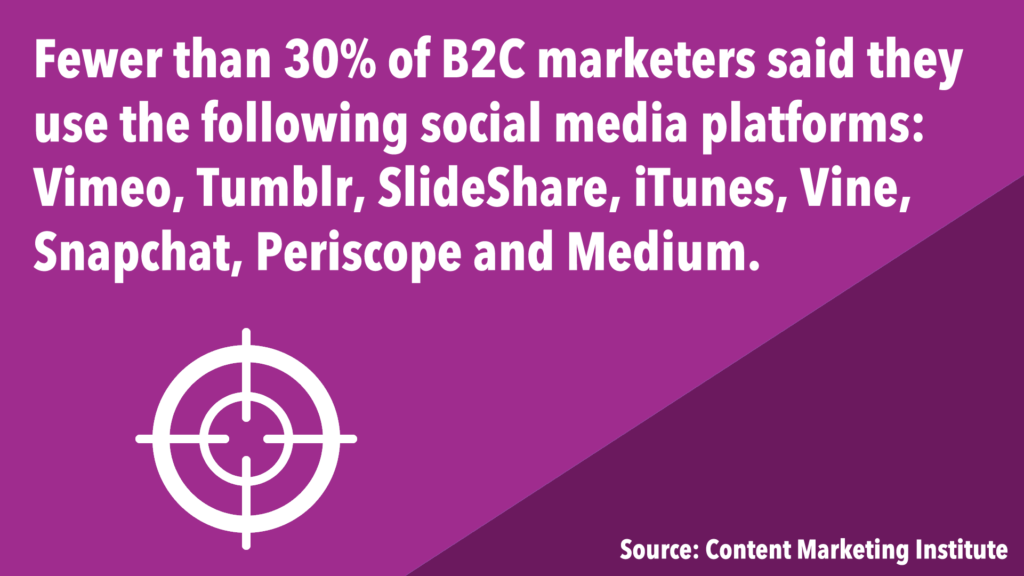
Noting which mediums marketers aren’t as active on can provide direction as to which social networks to invest in, since there isn’t as much competition there.
26. 48% of companies are not curating content. (Source)
With limited time and resources, it’s important to include the relevant content of others in addition to the original content you’re creating to share a mix of perspective and to help scale what you’re sharing without breaking the bank.
27. 73% of consumers are open to suggestions or predictive recommendations from brands. (Source)
Receiving a suggestion or recommendation from a brand doesn’t bother consumers once they are familiar with the company as long as the assistance is genuine and provides utility. Keep this in mind when promoting content to your existing audience as different segments of your customer base want to see different things from your organization, whether through email segmentation, targeting with social ads etc.
28. 63% of content marketers are currently working on better understanding their audience. (Source)
The process of researching the nuances of your audience is never ending as any customer base is continually evolving, changing their preferences and viewing your brand identity differently than they did the month before. Analyze your customer base on a consistent basis to stay ahead of the curve when it comes to creating and promoting relevant content your audience cares about.
29. 89% of companies said their content marketing programs are more effective now than in years past. (Source)
Content marketing is nothing new, but its popularity has spiked in the last few years, driving visibility to the strategies that work and the one’s that don’t. There will always be more to learn about being successful with content, but it seems like most businesses are starting to feel more confident.
30. 60% of Snapchat users upload personal items every day, while only 20% of users on Facebook-owned Instagram upload personal content daily. (Source)
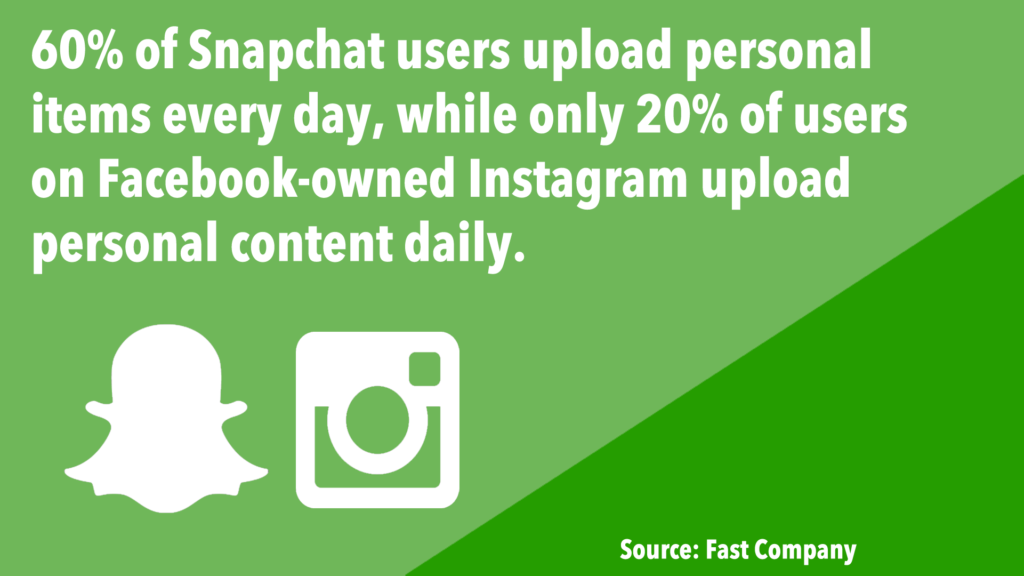
User generated content is another important element in your overall content strategy as it can help fuel your channels at a minimal cost or no cost to your brand. Develop ways of encouraging customers to create content related to your business on Snapchat, Instagram and elsewhere to increase visibility of your offerings and conserve your time and resources.
Content Marketing Hiring Statistics
31. 40.4% of marketers have two to four employees dedicated to content marketing. (Source)
As the impact of content becomes clearer, organizations are hiring more employees to assist with different areas of content to build stronger, more comprehensive teams to scale their efforts.
32. The number of LinkedIn profiles in the U.S. containing “content marketing” has increased by 168%. (Source)
As more journalists and marketers develop skillsets focused on content marketing and others notice the hiring spree in this area of marketing, more professionals will continue to cater their personal brands to adapt to roles in this niche.
33. The top ten states with the most content marketing jobs per capita are Massachusetts, New York, California, Illinois, Minnesota, Colorado, Washington, Georgia, New Jersey and lastly, Maryland. (Source)
Content marketing positions are available all across the country and remotely, but if you’re looking for a plethora of roles to choose from as a content marketer, these are the top states to look at.
34. 41% of respondents say the most important skill-set missing from their content marketing team is content creation. (Source)
Creating worthwhile content is difficult, as it requires a range of skillsets that many don’t have. Being able to create articles, videos, podcasts and other formats of content will be a competitive advantage for any content marketing professional.
35. The number of content marketing job listings on Indeed.com has grown by nearly 350% from January 2011 to January 2015. (Source)
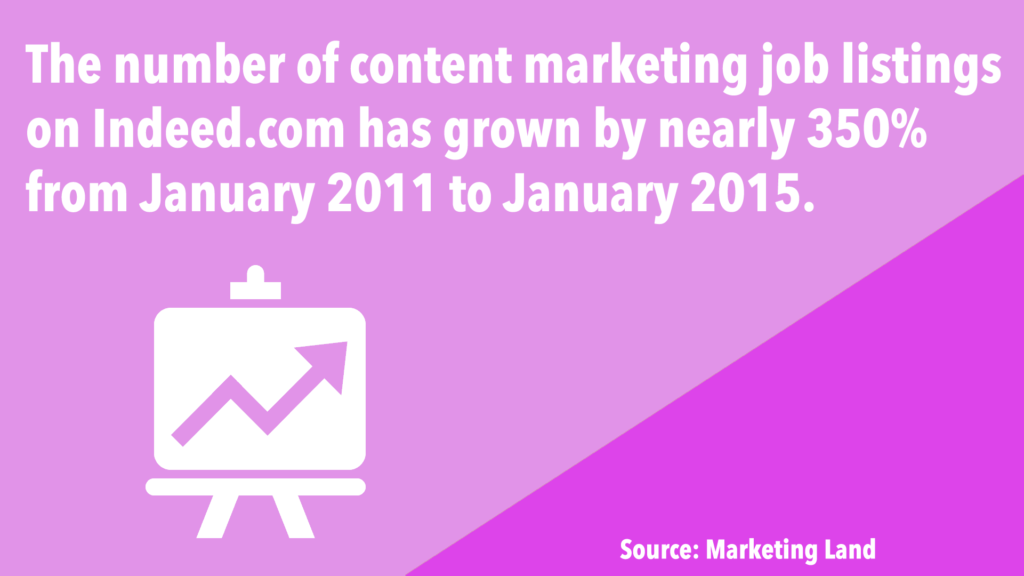
As other marketing mediums drive less results, more companies are investing in content marketing and as a result are hiring content experts to develop and promote content for their customer base.
36. At 38% of companies a director level position does the content hiring, 28.3% have marketing managers handle hiring and 16.9% of organizations have their CEO or founder manage hiring. (Source)
Who hires content marketers at most companies depends on who has the highest level of expertise on the subject, but in many cases, falls under the jurisdiction of the CEO/founder if there aren’t others specializing in content at the organization.
37. The average salary for marketers is $61,000, content marketers make an average of $74,000 annually. (Source)
Since content marketers are in high demand today, they can often command a higher salary than marketers in other related roles.
38. 60% of marketers report that hiring marketing content talent is “somewhat difficult”. (Source)
The range of skills a content marketer needs to have is diverse, which makes it hard to find qualified candidates. To succeed, content marketers need writing and editing skills, an understanding of how to promote content once it’s created, the ability to interrupt data and more.
39. According to respondents, Content Marketing Director/Manager is the most common title of the executive in charge of content marketing at an organization. (Source)
Content Manager as a title is likely common due to the fact that many content marketing teams are still small or consist of only one person who typically takes that title.
40. 51% of marketers and executives surveyed say they will have a content marketing leader by 2017. (Source)

Leadership is important for any content marketing endeavor to ensure every team member is motivated to give their best work towards reaching a company’s goals outlined in their strategy.
Content Marketing Measurement Statistics
41. 68% of marketing professionals today feel more pressured to show a return on their investment in marketing spend. (Source)
With access to more data points than ever today, there is a strong pressure on marketers to prove every action they are taking provides ROI. In many cases, ROI is unmeasurable and in some cases, it shouldn’t be the only focus of what you’re doing with content as other metrics for success matter.
42. Marketers who check their metrics 3X+ times a week are over 20% more likely to achieve a positive ROI. (Source)
The more aware a content team is of their success or lack of success with content, the more quickly they can respond to ramp up what’s working and alter what’s not.
43. 41% of organizations with content marketing programs say they see an increase in brand awareness. (Source)
Awareness is one of the many important goals to aim for with content as overtime it can lead to increased trust and position a brand in a stronger position as compared to competitors.
44. 83% of B2C companies say sales are the most important content marketing goal, while 85% of B2B companies say lead generation is a top priority in terms of goals. (Source #1 & #2)
Driving awareness isn’t enough with content marketing as customers must take action from that awareness in the long-term like increasing sales and leads. Develop a mix of hard and soft metrics to focus on with a content marketing to properly measure its effectiveness.
45. 50% of B2C content marketers and 57% of B2B content marketers find measuring content effectiveness a major challenge. (Source #1 & #2)
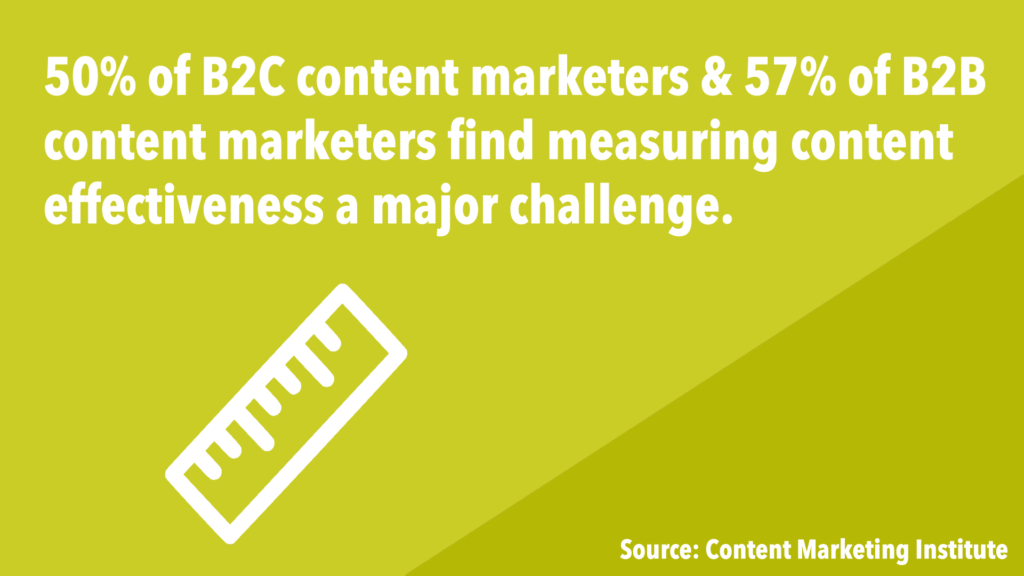
Measuring the ROI of content marketing has never been easy. Setting up a proper attribution model takes time, but today you’ve got more tools and resources than ever to help get that process in motion. Start small and work your way up to attributing more of your actions with content to measurable results.
Did I miss any important content marketing statistics, facts or figures worth including? Please let me know in the comments below.


